The snowshoeing season is coming. How about burning calories by snowshoeing instead of doing boring snowshoeing? You may have come to this post by chasing the question - what kind of boots do you need to wear with snowshoes?
But it’s a fun fact that snowshoeing can burn up to 630 calories per hour, though it depends on how hard you work. However, coming to the main points – what are the best winter boots for snowshoeing? What brands are good? What features make any boot best for snowshoeing?...
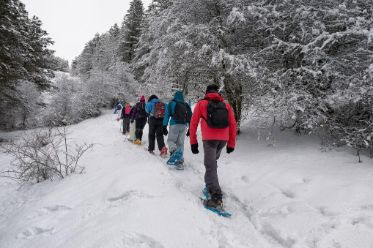
That’s why, alongside the best snowshoe boot reviews, I’ve put together a complete guide on choosing the best boots for snowshoeing for your unique feet and requirements. So, without further delay, let’s get started with a few reliable and trendy boots to wear with snowshoes.
LIST OF THE BEST BOOTS FOR SNOWSHOING
No. | Product Name | IMAGE | RATINGS |
|---|---|---|---|
1 | SALOMON X ULTRA 3 | 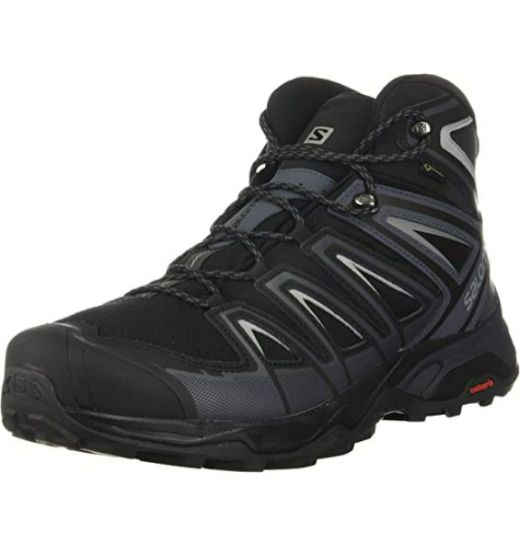 | |
2 | COLUMBIA BUGABOOT III | 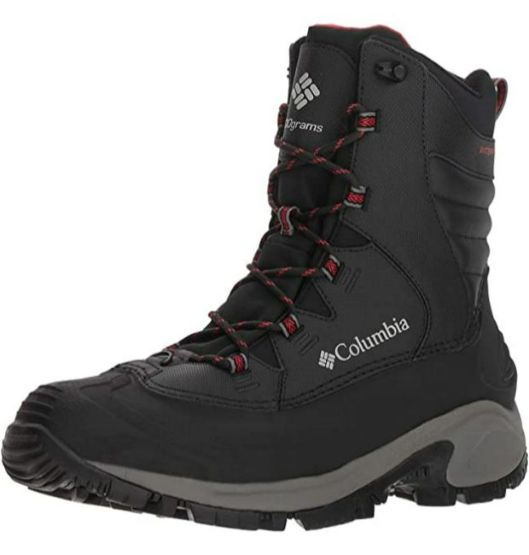 | |
3 | NORTH FACE SHELLISTA II | 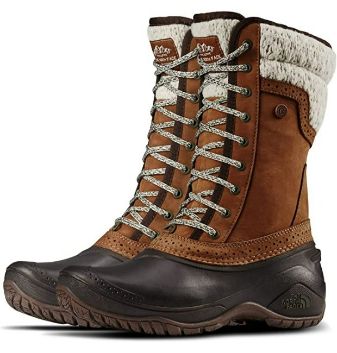 | |
4 | MERRELL THERMO | 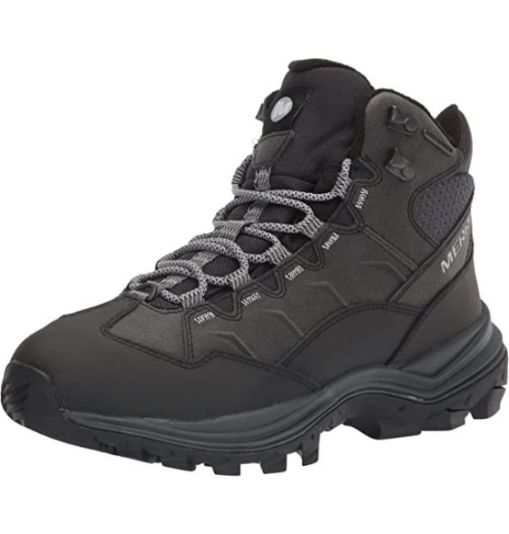 | |
5 | TIMBERLAND MEN'S CHOCORUA | 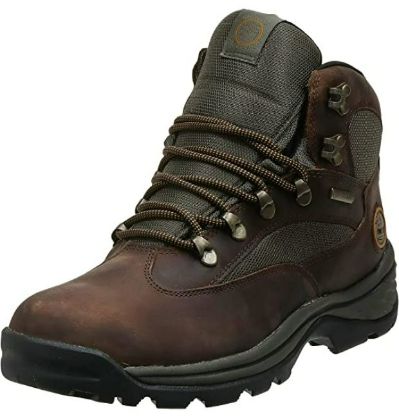 |
BEST SNOWSHOEING BOOTS REVIEW
1. SALOMON X ULTRA - BEST LIGHTWEIGHT BOOTS FOR SNOWSHOEING

Features
Salomon has won the trust of customers in producing outdoor sports gear like bags, boots, shoes, accessories, and apparel since 1947. These Men’s boots also have maintained the reputation of this brand unexceptionally.
These Ultra 3 boots are the upgraded version of the Ultra 2 range. These boots are lighter and slimmer and need less break-in time when compared to the latter. The fittings are neither narrow nor too wide, yet they are perfect for the feet. Hence, the shoes offer enough space to wear thick socks without being too tight on your feet. They help the users snowshoe for a long time without getting tired.
Moreover, these Salomon boots are waterproof. They restrict the moisture from entering the shoes to protect feet from getting cold while walking in the snow. The descent control technology helps to tackle the rugged descents even in wet conditions. They render unparalleled traction in all terrains to ensure a safe ride on snow.
These snowshoeing boots provide impressive insulation to the feet to keep them warm without affecting their breathability. The design with laces offers a secure fit for the users.
The sturdy, comfortable and breathable properties have made the shoes one of the best snowshoe boots among many options.
PROS
CONS
2. COLUMBIA BUGABOOT III - BEST EXTREME COLD SNOWSHOE BOOTS

Features
Columbia has proficiency in enriching the experience while performing outdoor activities by offering them outerwear, sportswear, accessories, and footwear. These snowshoes have maintained that trend beautifully.
The preoperatory OMNI-TECH technology of these shoes has made them waterproof, stain-resistant, yet breathable. This three-layered technology helps the shoes repel the water and wick the moisture from the feet by utilizing body heat.
Moreover, due to the Omni-Shield coating on the boots, they are better to feel and dry faster when compared with the Gore-Tex shoes. These shoes are more malleable than the latter. They offer easy movements and air permeable protection in snow.
These snowshoe boots come with TechLite midsoles that are lightweight. They render superior cushioning throughout the whole day performance and absorb shock efficiently in every stride.
These men’s shoes are made with different-sized treads in the specific zones of the soles to provide the best traction on all surfaces. These dual-zone tread patterns keep the feet in the proper place and prevent them from sliding to ensure the stable movement of the users even in a difficult situation on snowy surfaces.
With the waterproof leather uppers, 200g insulation, injection molded rubber shells, cold-optimized tread, and sturdy lacing system, these shoes have successfully ensured their name in the list of the best boots for snowshoeing.
PROS
CONS
3. THE NORTH FACE SHELLISTA II - BEST EXTRA-WARM BOOTS FOR SNOWSHOEING

Features
When picking up the proper snowshoeing boots, one must be wise in choosing the perfect material. The material should restrict the cold from penetrating inside the shoes. Moreover, the shoes must trap the heat and carry it to the body to keep the feet warm. These snow boots are perfect in this regard.
The 291 g PrimaLoft Silver Insulation has made the shoes lightweight and compact without restricting their performance. This insulation material allows the wicking of the moisture from the feet proficiently. Hence, the feet remain warm even if they sweat.
These waterproof shoes are efficient enough to keep the feet almost five degrees warmer than the outside temperature with a thin sock. Moreover, these shoes dry soon after getting wet. Henceforth, they are the perfect choice to use in cold and wet outdoors. They allow you to enjoy a camping session in winter.
The suede and nubuck uppers of these mid-cut shoes render an impressive water-resistant performance. They are long-lasting and able to withstand scuffing during snowshoeing.
The waterproof TPR shell of these shoes is more elastic than PVC shoes. They can handle the wear and tear of harsh weather more magnificently than the latter.
The insoles render moderate arch support and cushioning to the feet. The fittings are perfect for wide calves. The rubber soles of the shoes provide excellent traction while walking on snow.
To conclude, these snowshoe boots come in attractive colors and stylish looks and are the best companion for adventurers in cold weather.
PROS
CONS
4. MERRELL THERMO SNOW BOOT - BEST INSULATED BOOTS FOR SNOWSHOEING

Features
Do you love to do snowshoeing but are not satisfied with your existing shoes for these activities? Are you confused about what kind of boots to wear with snowshoes? These snowshoes are the exact answer to your search.
The shoes are lightweight yet warm enough. Another great plus is the waterproof membrane that seals out the water but allows the moisture to escape from the feet to offer the wearer a breathable environment.
The rubber toe caps of the shoes protect the toes and enhance their durability. The Fleece lining of these Merell boots has made them efficient to tackle the temperature even below zero degrees Celsius.
While the Moulded nylon arch shank and the EVA foam midsoles ensure stability and comfortability, the Kinetic Fit BASE insoles provide flexible support for protected movements during snowshoeing.
The rubber outsoles grip the uneven surfaces with excellent capacity in snow. The size of the boots is perfect. They have extra room to accommodate a heavy sock. The unbeatable traction, water resistance property, and proper insulations describe these snowshoe boots best.
PROS
CONS
5. TIMBERLAND CHOCORUA - BEST WATERPROOF BOOTS FOR SNOWSHOEING

Features
Proper insulation, water-resistant capacity, contoured comfortability, and mind-blowing tractions are the most concerning characteristics when looking for the ideal boots for snowshoeing. These mid-cut boots have ticked all these essentialities with great success.
The full grain leather and mesh upper of these shoes have made them sturdy and flexible. They are not bulky but shine in their performance. This material ensures maximum ventilation around the feet. It cooperates with the TimberDry membrane and fully gusseted tongue to stop the water from coming inside the shoes and allows the air to come in. Thus, they keep feet healthy, toasty, and dry.
The adjustable rustproof laces of the shoes help to achieve a customized fit for the individual feet. The compression-molded EVA midsoles of these men’s shoes can endure all rugged terrains. They provide magical stability and comfort to the users’ feet by absorbing impacts on each stride while snowshoeing.
Moreover, the uniqueness of these Timberland shoes lies in their arch and ankle support and tractional soles. All the previous features have made these boots an integral part of the list of best warm boots.
PROS
CONS
6. KODIAK SURREY II - BEST WOMEN’S BOOTS FOR SNOWSHOEING
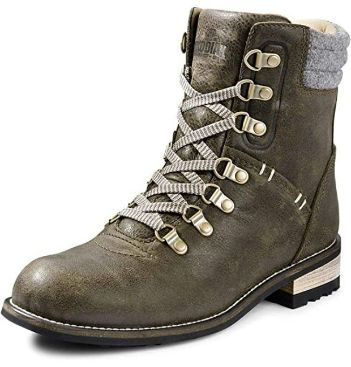
Features
When the classic style and efficient performance blend without flaws, these Kodiak shoes appear on the scene. You can ignore the capabilities of these shoes if you are looking for a perfect pair of boots for snowshoeing.
These boots for snowshoeing women come with 200 GM of Thinsulate insulation that resists water to keep feet dry. These insulations have made the shoes lightweight and long-lasting. They absorb less water so weight hardly increases by less than 1% of the shoe’s weight and keep your feet warm even in a damp environment.
These boots are flexible enough to mold to the wearer's feet and render an optimum level of comfort and support to the feet.
The rubber soles of these boots for snowshoes have made them robust. They offer outstanding traction on treacherous, icy surfaces. These boots are true to size and leave sufficient room for thick socks.
The slick, stylish design with required grips is the USP of these boots for women.
PROS
CONS
7. CHACO BOREALIS QUILT - BEST LEATHER-FREE BOOTS FOR SNOWSHOEING
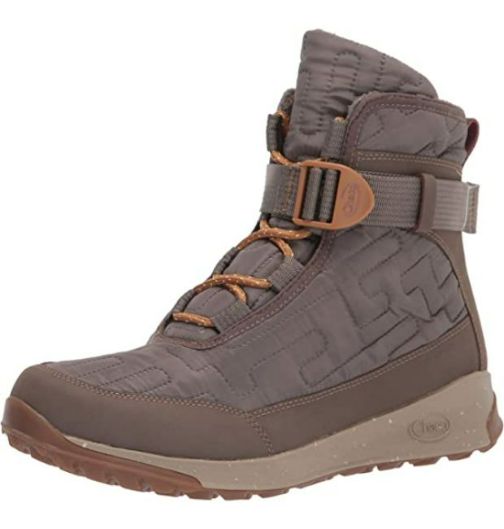
Features
In order to keep your toes cozy during snowshoeing, you have to keep in mind a lot of restrictions while choosing a snowshoe. One needs to prioritize and secure the health and hygiene of his feet before opting out for classy-looking stuff.
These women's boots for snowshoeing elegantly meet all the requisites at ease. The most attractive feature of these boots is the material which is derived from coffee beans. Being so, they provide the optimum natural insulation which retains the internal body heat during your strides through the snow. Additionally, it has a marvelous feature that returns the body heat and thus keeps the feet comfortable and cozy.
These snow boots for snowshoeing come with non-marking ChacoGrip rubber soles and are enhanced by super grippy diamond lugs of 3mm depth for providing trustworthy traction. Moreover, it has seam-sealed waterproof construction that resists water from coming in.
In a nutshell, if you are looking for a handy, comfortable, super-insulated snow boot that can be used for other purposes as well, this one suits your search.
PROS
CONS
8. OBOZ BRIDGER INSULATED - BEST ULTRA-DURABLE BOOTS FOR SNOWSHOEING
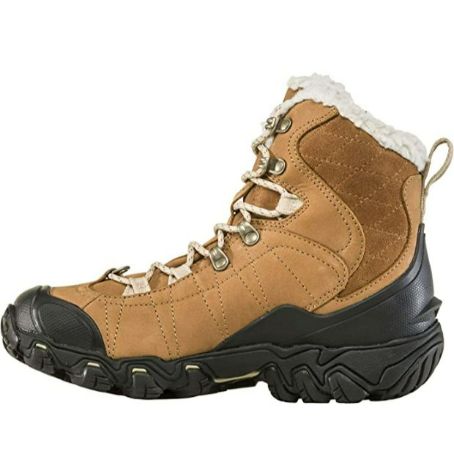
Features
The list of best women's boots for snowshoeing remains incomplete without these Oboz Bridger shoes. These boots have successfully engraved their name in the recommendation by their exclusive performance.
These boots come with BDry breathable and waterproof membranes that keep the feet dry by allowing proper ventilation. The 200g 3mmThinsulate insulation keeps the feet warm on the other side. Moreover, it has nubuck leather uppers that add durability by keeping the unwanted elements out. These uppers restrict water from coming in.
Furthermore, these women's snowshoe boots come with molded rubber toe caps that not only protect the toes from impacts and collisions but also improve their durability. Additionally, it is featured by the wool-topped thermal insoles that insulate the bottom of your feet from the surroundings and provide support and comfort.
To summarize, the union of the waterproof upper material, rubber-made soles, and thermal wool-topped insoles make these boots a shivering possession in the snowshoer fraternity.
PROS
CONS
9. NORTIV 8 ANKLE-HIGH HIKING BOOTS (MEN)
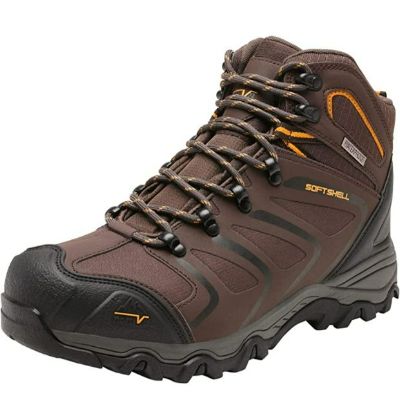
Features
Hiking through the trails and snow becomes more adventurous when your feet cooperate with you day in and day out. To accomplish that, one needs to wear a pair of boots for snowshoeing that are lightweight, flexible, easily removable, weather friendly, and shock absorbent. These Nortiv Men’s shoes offer you all of those under one roof.
The shock-absorbent cushioned insoles of these snowshoeing boots offer the best support for your feet. The flexible and lightweight EVA midsoles, designed for long-lasting comfort and superior cushioning, eventually reduce foot fatigue. The padded tongue and collar keep the feet by rendering improved support to the ankle. They protect the feet from rubbing against the laces. Moreover, the rubber toe caps secure the feet from injuries and collisions.
These hiking boots offer the users excellent static water-resistant performance. The durable shoe laces render a perfect fit.
Nortiv Men’s shoes come with high-quality, non-slip, and durable rubber soles. These soles have 5mm-deep Lugs and are completely slip-free. They provide excellent advanced traction that ensures firm stability of feet on challenging terrain.
With these brilliant features, these shoes have turned out to be perfect for multipurpose activities like hiking, hunting, camping, climbing, backpacking, trekking, mountaineering, traveling, and so on.
PROS
CONS
BUYER’S GUIDE - BEST SNOWSHOEING BOOTS
Type and Fittings
People often wonder about what kind of boots for snowshoeing will be ideal. There is no specific answer or suggestion for this confusion, as everyone has unique feet, and some brands are good for wide feet, while others are better for narrow ones.
For suggestions, it can be said that the insulated winter hiking boots are better than traditional floppy winter boots in terms of offering support for your ankles and cradling your feet.
With that said, another suggestion is - don’t buy boots based on any reviews you get from the internet or the ones; that work for your friend’s feet. Make sure the chosen shoe has enough room to wear thick winter socks and insert orthotic insoles to ease foot fatigue after the activity.
For better fittings, try on any good boots for snowshoeing on the day after your feet swell a little bit. After lacing them up all the way, walk around on a flat surface and walk up and down stairs to check the possibility of heel slippage due to unmatched size.
Foot and Ankle Support
You never know how the surface is covered by snow. Moreover, the surface could be slippery, or feet can sink into the accumulated snow. If you step on any unstable area, it can wrench your ankles into an uncomfortable position unexpectedly.
So, you need well-supportive boots that can protect your ankles, but the amount of foot and ankle support you need would be your personal preference. Generally, boots for doing activities in cold areas across the snow come with a high shaft; that could restrict your movement a bit. So, choose only one in which you can feel comfortable walking around.
Insulation
As I mentioned above winter hiking boots with excellent insulation are the best boots to wear with snowshoes. Hence, some manufacturers have made their winter versions by adding a little bit of insulation to their summer hiking boots.
On the other hand, you may have noticed that some expensive, expedition-worthy snowshoeing boots are rated for withstanding -40 and get worried seeing that the winter boots are having only 200g of synthetic insulation. Don’t worry! It will provide enough warmth to keep your feet comfortable while snowshoeing on snow.
Since it’s an aerobic activity, so it will warm up your body. Hence, a moderate amount of insulation is enough for this activity. If you go for those warm polar expedition-worthy shoes, they could overheat inside and make your feet sweaty and wet during snowshoeing.
Soles
Winter boots usually have a sole similar to a snow tire; that has a large surface area, sticky rubber, and deep lugs. Whatever materials are used for the outsole, make sure the sole provides ample grip and traction over the snow-covering areas.
Breathability and Waterproofing
Since you’ll be walking in the snow, having a waterproof boot is a must for snowshoeing. The leather and some synthetic materials have excellent water repellent power, though the waterproofed membrane of synthetic material could suffocate your foot.
That’s why most hiking shoes come with innovative waterproofing technology. They feature a waterproof-breathable membrane between the inner lining and outer fabric to keep it water-resistant at the same time breathable. So, make sure your chosen footwear has breathable waterproofing.
Care and Maintenance
A quick wash is enough to rinse out the salt and dirt from the boots. After washing, leave them as they are at room temperature in a well-ventilated spot for air drying. Never soak them in water or use any harsh soap or detergent.
FAQ
1. How much do snowshoeing boots cost?
Depending on the brand, material used, and features included, the reliable snowshoeing boots are available in the market with a price tag that ranges from $50 to around $250.
2. Can you use regular boots with snowshoes?
On a positive note, the snowshoes generally adjust to fit a growing range of boots or shoes. You can wear something that keeps your feet comfortably warm and dry during snowshoeing. So, running shoes or regular four-season boots work well for snowshoeing.
3. What are the best types of boots for snowshoeing?
Waterproof, well-insulated winter hiking boots with thick soles and leather or rubber uppers are ideal boots for snowshoeing.
4. Are waterproof boots good for snow?
Sturdy waterproof hiking boots also work great with snowshoes; if you wear them with breathable, woolen, or synthetic socks.
CONCLUSION
Before wrapping up, to be honest, one thing more to mention is that some of the recommended shoes are my personal choice; I’ve tried and tested them before reviewing them. That doesn’t mean you can’t rely on other options; I’ve enlisted them considering the reviews of real users.
You are also welcome to keep your search on, but make sure to consider the points; I mentioned in the buying guide. For this reason, I’ve tried to include everything you need to know to buy your first pair of snowshoeing boots.
Hopefully, you’ve liked my recommendations and found the information useful. If so, don’t forget to share this article with your friends and leave a comment below about your experience with your new pair of boots for snowshoeing.
Charles is a Registered Nutritionist with a Master degree in Clinical Nutrition from New York University and a Bachelor degree in Nutritional Sciences from The Pennsylvania State University. He actively contributes to all trending fitness products and aims to provide consumers with reliable information and review fitness products. Thomas Berumen has an extensive fitness background. He has been working as a personal trainer for the past eight months. He is so dedicated and passionate to lead an active and healthy lifestyle and motivates his readers to do the same.
